Planting tulips by March 8
Planting tulips is the most important stage in flower cultivation by March 8th. It depends on how correctly the bulbs are planted whether the plants will give buds by the required time.
Calculation of landing dates
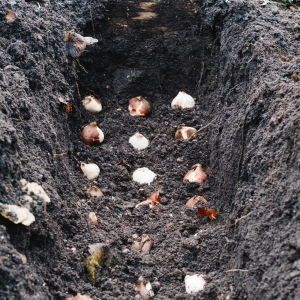 When determining the timing of landing, the following factors are taken into account:
When determining the timing of landing, the following factors are taken into account:
Indoor temperature
In order to quickly grow tulips and make them bloom by March 8, it is important to create the right temperature readings at certain times.
Bulb rooting time. This period takes 4 to 8 weeks.
Timing from planting to flowering
Varies within 16-20 weeks.
Tulip variety. The duration of cultivation varies depending on the variety.
To simplify the calculations, use the following formula: from March 7 (the time of collecting flowers) 3-4 weeks are taken (the period of germination of the bulbs) and 16-18 weeks (the period from germination to flowering). To get flowers by March 8, they are planted from December 26 to November 7.
Preparing the greenhouse and soil for forcing tulips

Before planting tulips, you need to prepare the soil. Otherwise, the plants will get sick.
The soil should be light and water permeable. For its manufacture, sand and sawdust are mixed in equal proportions. Drainage must be used: crushed brick, expanded clay, fine gravel, shell rock.
To disinfect the soil, it is calcined in the oven at maximum temperature for ¼ hour. When the soil has cooled, it is watered with a dark pink solution of potassium permanganate or "Fitosporin". Drainage is treated in the same way.
The bulbs are planted in wide boxes 15 cm deep. They are disinfected by soaking in a dark pink solution of potassium permanganate or pouring boiling water over them.
The greenhouse is fumigated with sulfur, and the walls are wiped with a solution of copper sulfate - 1 tbsp. l. for 10 liters of water.
For forcing tulips, you will need special equipment. It is imperative to use phytolamps and heating devices - without them it will not be possible to create the necessary conditions.
Preparation of planting material
It is important to prepare the planting material before planting:
- Calibration. Before planting, the bulbs are sorted out and checked for stains and damage. Smaller specimens germinate later, so they are planted several days later than large ones.
- Cooling. To make the bulbs germinate faster, they are placed in a room with a temperature of + 9 ° C for 2 weeks.
- Cleaning. The bulbs are peeled from brown husks. To ensure the quality of the planting material and to speed up its germination, the bulbs are checked for damage, mold and stains.
- Disinfection. The planting material is soaked for 40 minutes. in a dark pink solution of potassium permanganate or celandine broth.
Step-by-step landing instructions for beginners
Tulips tolerate a thickened planting well. The bulbs are stirred close to each other. For 1 m² - up to 300 plants.
The bulbs are planted in the ground with the bottom down. They are buried 3-4 cm and covered with sand. Then they are poured abundantly with water at room temperature. If the bulbs become bare, they are again covered with soil.
Storing bulbs for forcing
Temperature is of paramount importance in the first stage of forcing (storage of the bulbs). By changing the temperature in one direction or another, you can control the development of tulips and, to some extent, the timing of their flowering.
The temperature effect on bulbs during storage consists of two stages:
- first - exposure to high temperatures,
- the second - reduced.
The storage regime for bulbs to be forced is slightly different from the storage regime for bulbs that will be planted in open ground. The storage regime is significantly different only for those bulbs that are intended for early and late forcing.
After the bulbs are excavated, which is carried out at the usual time for tulips, they are stored at a temperature of 20-23 ° C for a month. This temperature is considered optimal for the formation of flower rudiments in the bulb.Then, during the month (August), the temperature is maintained at about 20 ° С, and in September it drops to 16-17 ° С.
Such storage temperatures roughly correspond to the average temperatures during these months, therefore, during storage, no special equipment is required to maintain a given mode in the storage. Minor deviations from the indicated temperatures do not have a significant effect on plants. However, with significant temperature deviations in any direction, the processes of flower rudiment laying in the bulb slow down or anomalies appear in the form of "blind" buds.
The difficulty of forcing for the New Year is that by the time the bulbs begin to cool, all parts of the future flower should be fully formed in them. In the middle lane, the rudiments of a flower are fully formed by mid-August, and with a cool and rainy summer, this period may be postponed by another month. To speed up the laying of all the flower organs and start cooling the bulbs at the scheduled time, there are two ways: agrotechnical and physicochemical.
The agrotechnical method is that tulips are grown under a film and decapitation of flowers is carried out. This method allows you to speed up the process of laying all the organs of the future flower by 2-3 weeks.
The second way is to dig up the bulbs early. The bulbs are dug up as soon as yellowish spots appear on their covering scales. Then the bulbs are kept at a temperature of +34 ° C for a week. This temperature also helps to speed up the process of laying the organs of the future flower in the bulb. The bulbs prepared in this way are stored in the lower section of a regular home refrigerator from mid-August until the moment of planting.
The purpose of this preparation is to retard the development of leaf buds in the bulb and thereby enable the buds of flower organs to form faster in it.
Planting tulip bulbs for distillation. Kevin lee jacobs
Planting bulbs in the ground

Planting process
Regardless of the preliminary preparation of the bulbs, this step is the same for any method of growing tulips at home. Germination of tulip bulbs begins with their rooting in a special substrate. The composition of the substrate can be very diverse. The main requirement for it is a sufficiently high fertility and a normal level of acidity (6.5 - 7); the latter means the need for liming substrates with peat and sawdust.
For winter cultivation, it is also undesirable to use pure garden soil, since it becomes denser from watering, decreasing in volume. There are two main recipes for the substrates used in winter tulip cultivation.
One of them uses ordinary soil as a base:
- 2 pieces of garden land
- 1 part compost
- 1 part coarse sand
The second is softer, since it is based on sawdust:
- 2 parts sawdust
- 1 part of soil
- 1 part humus or compost
It should be remembered that every 5 kg of sawdust should be limed with 1 glass of charcoal.
One of the requirements for a container for growing is the possibility of air penetration to the roots of the plant. Therefore, if you have few bulbs, you can get by with several ceramic pots (ceramics has the ability to pass air), 15-20 cm in diameter and at least 15 cm high. One onion sits in one pot.
If there are a lot of bulbs, it is recommended as containers for growing standard vegetable boxes with perforated walls. The best option is a standard 60 x 40 cm drawer with a height of at least 15 cm.

An approximate view of a box for winter cultivation of tulips
- The bottom of the box or pots is covered with a drainage layer, which is 1/5 to 1/3 of the height of the sides
- Expanded clay or medium-sized rounded pebbles are selected as drainage. It is not advisable to use flat stones.
- Next, a layer of soil up to 3 cm high is laid on the drainage, on which the bulbs are exposed
- Before planting the bulbs, it is advisable to hold them in a warm solution of potassium permanganate for half an hour
- The bulbs can be of different heights, so it is necessary to pour the substrate under some of them so that all the tops are on the same level
- The density and method of planting bulbs in boxes can be very diverse - from rare point plantings according to the 10 by 10 cm scheme, to dense plantings, when the bulbs are practically in contact with each other
- After installing the bulbs in a box or pot, sprinkle them with a layer of substrate of at least 1 cm and water abundantly
- Further, the box is sent to a cold dark room, where the time stays, depending on how the distillation will be carried out.
- It is advisable to take out the box for half an hour for airing once a day; watering is carried out once a week
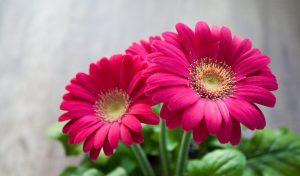
Gerberas: how to grow a tropical flower at home. Description, varieties, care, reproduction, possible diseases (50+ Photos & Videos) + Reviews
Tulip distillation technology
Moving boxes with sprouted bulbs into the light should be started when the sprouts reach 5-6 cm, and the flower rudiment will go beyond the storage scales and will be felt in the lower part of the shoot.
Temperature. When transferring boxes to the light, the temperature should not exceed + 12 + 14оС. After 3-4 days, the temperature is raised to + 16 + 18C during the day and + 14 + 15oC at night and give full illumination. When the buds begin to color, the temperature is lowered to + 15 ° C. At the same time, the flowering period is extended, the flower becomes large, and the flowering stem is strong and high. By lowering the temperature during the dyeing period or somewhat earlier, you can bring the flowering to the target date. However, it should be borne in mind that a decrease in temperature during the day by 2.5 ° C from the norm delays the onset of flowering by one day.
In case of a delay in flowering to the target date, an increase in temperature to + 20 ° C can bring flowering closer by 2-3 days.
Lighting: In the first 3-4 days, the lighting is poor. If the sprouts are small - 3-4 cm, then they are shaded with a black non-woven covering material, trying not to touch the sprouts. Every day, for 1-1.5 hours, the shading is removed, and the room is ventilated. In 2-3 days, the sprouts grow up to 6-8 cm, then the shading is removed and full light is given.
Chilled large bulbs require little light when forcing. However, illumination matters and affects the quality of the cut. It has long been established that the illumination of 900 lux is the minimum "threshold" at which all plants bloom. At 800 lux, bulbs of 1 parsing do not bloom.
Even in sunny February, tulips need to extend the daylight hours by 3-5 hours, otherwise the leaves will be poorly colored. For 1 sq. m requires additional illumination of 40-60 W, and the total length of daylight hours should be 10-12 hours. Phytolamps are suspended at a height of 0.5 m and maintain this distance during plant growth.
Watering is done daily in the morning, avoiding water getting on the leaves.
Tulips should be watered with cold water (+ 8 + 12оС), better thawed, because it contains a minimum amount of salts and acids. In the first 7-10 days, it is better to water every other time with a 0.2% solution of calcium nitrate, which promotes the formation of strong peduncles, highly decorative flowers and increases flowering productivity.
Top dressing. The process of forcing bulbous plants is entirely due to the mobilization of nutrients accumulated in the storage scales of the bulb. The forcing period is only 16-30 days, and in the conditions of the greenhouse, the feeding does not have time to be absorbed. When cultivating tulips in boxes on poor soil in good lighting conditions, it is still advisable to feed with a special liquid fertilizer for bulbous plants. However, excess fertilizer causes leaf burns and adversely affects the quality of flowers, and can also delay flowering by 1-6 days.
It was noticed that feeding 40 g of potash and 20 g of ammonium nitrate per 10 liters of water 10-12 days after the addition helps to preserve the bulbs after forcing.
Plants bloom on average after 3 weeks exceptionally amicably (within 2-3 days) and bloom for 7-10 days. Even with the same planting times and bulb preparation regimes, the period of their flowering, depending on the conditions of the year, can vary within 6 days. If at the time of staining the buds, the temperature is reduced to + 10 + 12 ° C, then flowering lasts 10-14 days.
Continued in the articles: Varieties of tulips for distillation,
Tulip varieties for forcing in pots,
Forcing tulips. Flowering acceleration techniques,
How to grow large quantities of tulips for sale at home by March 8?
Some are so good at growing tulips at home that they are now planting flowers for sale. At the same time, there is an opportunity to get seedlings no worse than from a personal plot.
What you need:
- boxes, at least 15 cm deep, or plastic containers;
- the soil;
- chilled onions.
A favorable time for planting is early September.
As you know, tulips germinate in the spring, as soon as the first snow begins to melt. In this case, the bulb undergoes temperature changes, and also depends on moisture. It is these factors in the spring that are the most favorable for the flower and contribute to its active growth.
Know
It is not difficult to grow tulips for sale even in winter, the main thing is to observe the correct regime, from time to time rearranging the boxes from one environment to another.
The soil
Prepare the soil substrate:
- river sand (1 part);
- sod (2 parts);
- humus (part 1).
You can buy ready-made soil, for this order bags of soil in a flower shop. Selected boxes are ½ filled with prepared soil.
Making a drainage layer
To prevent water from stagnating, it is necessary to prepare a drainage layer. For these purposes, use:
- expanded clay;
- moss-swagnum;
- sawdust;
- and other materials.
Preparing the bulbs
First, take a good look at the planting material. Remove bulbs with signs of rot and mold. Now soak them for about 30 minutes in a pale pink potassium permanganate solution.
It's important to know
Potassium permanganate disinfects the surface of the bulb, kills bacteria and prevents the occurrence of diseases in flowers.
Ground penetration
Planting material is placed in a box in rows - the bulbs should be 1 cm apart. Now the bulbs are embedded in the soil and sprinkled with earth to the top. Water abundantly. The earth shrinks.
As with growing in pots, the tulip should be 1/3 airborne. If, after watering, the ground subsided very much, then add more substrate - to the desired distance.
Where to put the boxes?
First, the boxes are placed in a dark, cool room, the temperature of which is 10 degrees. This makes it possible to create conditions close to the natural growing environment of tulips. Your bulbs will sprout quickly.
Plants should be watered from time to time.
A little advice
The main thing is not to pour the flowers, so that mold does not form on the ground. One watering per week is enough.
The first shoots will be visible in 2-3 weeks. As soon as the plant reaches 6-7 cm in height, transfer it to a room with a temperature of + 18-20 degrees.
When buds appear, move the boxes with flowers again to a cooler place. For this purpose, you can choose cold window glass. It is the low temperatures that contribute to the fact that the buds will bloom much longer.
Extending the flowering of a tulip
Tulips cannot tolerate dry air - in the natural environment they germinate at a humidity of 80%. Spraying with water, but so that it does not penetrate the buds (because of this, they can fade).
How to grow tulips by March 8: the right lighting
Flowers need to be taught to daylight gradually. For this purpose, the sprouts are first covered with a paper cap.The air temperature is also regulated by increasing it gradually.
It's important to know
If you immediately transfer the flowers to a room with room temperature, the stem of the flower will be thin, which will not allow the bud to gain all its power. In addition, a plant may develop a disease such as fusarium (damage to the leaves of a flower).
It should be noted that tulips love a lot of light, so the usual daylight is not enough for them. When planting flowers for sale, make sure that the room has a piece of light from lamps - at least 10 hours.
Consequences of a lack of light
Poor illumination leads to lengthening of the tulip stem, and the color of the petals turns out to be too pale.
Flowering plant care
Do not forget that flowering plants also require some care. So, for example, they should be watered no more than twice a week. Top dressing with liquid fertilizers - once a month. It is also necessary to monitor the appearance of yellowed leaves, which should be removed - this is necessary so that they do not take away the strength from the flower.
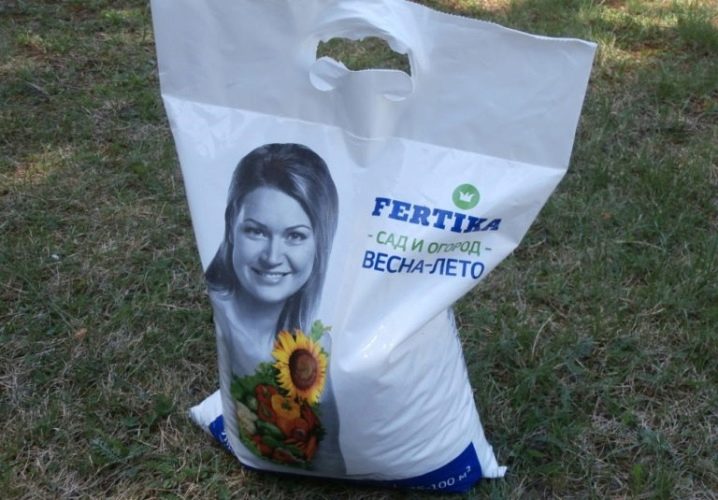
The plant must be protected from possible drafts. Daylight hours for a blooming tulip should be at least 6 hours. In order to keep flowering longer, it is worth installing a pot of tulips in a place where there is no hot battery and heating devices. From time to time, be sure to ventilate the room.
Summing up, we can say that you should not be afraid to try something new and unusual. You just need to please your loved ones, and do everything possible and impossible for them. After all, a do-it-yourself tulip donated for a women's holiday or Valentine's Day will bring much more pleasure than one bought at the market or in a flower shop.
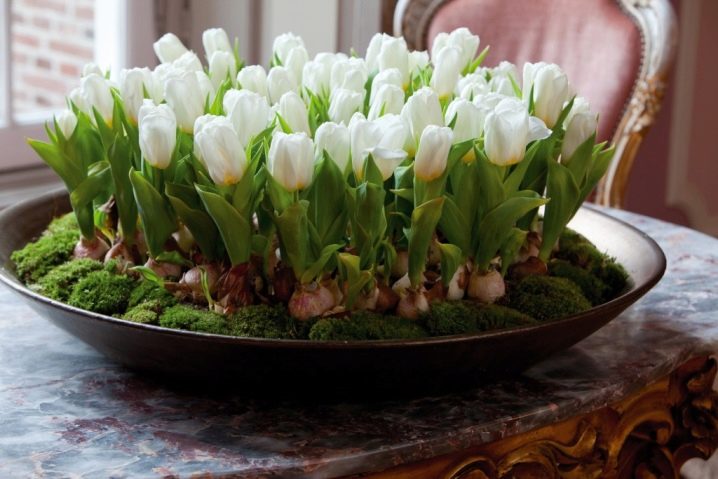
For forcing tulips at home, see the video below.
How to feed tulips for better growth and lush bloom
Bulbous flowers grow regardless of the season (even in severe frost in winter) only because all important processes take place inside the bulb
Therefore, it is important to nourish the plant not so much during flowering, but also the bulb itself before planting in the ground.
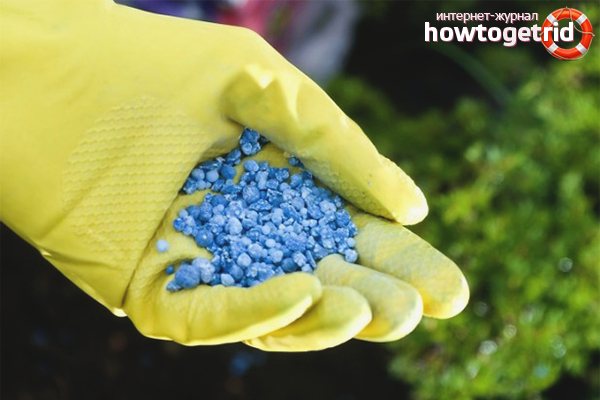
- Heteroauxin is a potassium salt with a phytohormone of the auxin family, which promotes the growth of the plant itself and its root system. It is produced in the form of tablets. Can be used for propagation of an adult bulb. After dissolving 1 tablet of heteroauxin in a liter of water, the unseparated onion with the "children" is placed in the solution for 15-24 hours. This procedure will induce active root growth, while untreated bulbs will produce 2-3 roots. The more roots and the thicker they are, the more chances the “kids” have to survive. Also, the bulbs are kept in a solution of the drug before planting for better rooting.
- The liquid drug Narcissus increases the resistance of tulips to diseases and microorganisms, heals small wounds on the bulb, destroys the spores of pathogenic fungi. A preparation of natural origin, the main active component of chitosan is an extract from the shell of crustaceans. Absorbs radionuclides, pesticides, salts of heavy metals, stimulating the production of immunity and protective enzymes. The use of the drug accelerates germination by a week. The plant is fed with a solution of ½ a cap of Narcissus per liter of water by watering it under the root every 2 weeks. It is also recommended to spray an already adult plant from a spray bottle with the same frequency.
- Natural growth regulator Zircon is made from Echinacea purpurea extract, known for its immunostimulating properties. The drug will help tulip bulbs to adapt to new conditions (before taking the bulbs from the balcony to the room), will have an antioxidant effect. If it is impossible to create an optimal microclimate for tulips (moist air and soil, indirect sunlight, a lot of light), then Zircon will protect the plant from possible diseases. Flowering thanks to Zircon will not suffer, the buds will form large, tight.One capsule of the drug is dissolved in 5 liters of water for root feeding.
- Liquid preparation MisterCvet Universal is suitable for feeding all indoor plants, including bulbs. Contains macronutrients (nitrogen, potassium, phosphorus), trace elements (magnesium, zinc, manganese, copper), phytohormones, minerals and amino acids. Promotes excellent flowering, fast growth and healthy appearance of tulips. 1 cap of the preparation is dissolved in a liter of water for root feeding. Promotes the formation of a large stem, a large voluminous bud and a bright flower color. Top dressing is carried out every 2 weeks. The solution is suitable for all indoor plants.
Tulips are convenient because they are unpretentious, and they can be grown for almost a whole year. It is not recommended to choose exotic varieties for home distillation (parrot, peony or lily-colored varieties), because they are capricious and demanding on the microclimate. A short, sturdy stem will look much better than a long and thin stem. It should be noted that the color of a tulip grown at home will not be as bright as that of a flower grown in a garden. However, with proper care and in your apartment, you can admire the unusually beautiful flowers and inhale their aroma for 2 weeks, even when there is severe frost and snow drifts outside the window.
how to grow a rose from a cut flower
Bulbous garden
This is a large composition (usually at least 3 square meters), in which flowers are complemented by stones, pebbles, gravel or beautiful driftwood or roots. It is better to choose the form for the composition not geometric, but landscape. Plant bulbs within the "garden" in clumps, alternating different species and varieties.
And perennial onions can also be introduced into the garden (edible: slime onions, sweet onions, chives). Their greenery goes well with blooming tulips, daffodils, hazel grouses and alliums. After all, perennial onions are also bulbous, and they bloom beautifully too.
The bulbous garden involves the use of decorations. It can be supplemented with terracotta or chamotte figurines and even ceramic tiles dug into the ground.
Dumping (mulch) is very desirable - it is also a means of artistic expression. Dumping from pine bark or decorative chips (tinted) is well suited to bulbous flowers. You will find other ideas in the article Related materials for the device of rockery.
Propagation of tulips
Vegetative methods are essential for the propagation of all tulips. The easiest option is to separate the daughter bulbs and plant them as independent plants. Daughter bulbs are formed in tulips annually, at the base of the scales. When transplanting, the nests are divided and all plants are used as independent ones.
The seed method is used only for plant breeding and breeding new varieties, mainly for species of wild-growing tulips; private gardeners use it very rarely. Seedlings of tulips bloom only 4, or even 6-7 years after sowing. The plants are grown for the first few years in containers until at least a small bulb is formed, suitable for classical planting in the ground.
Tulips for sale
Selling tulips for the holidays is a pretty lucrative business. The cost of selling both retail and wholesale lots of flowers differs significantly, and the associated costs are quite low. This is primarily due to the fact that most of the time during the forcing of plants, they are stored at low temperatures, which can be done in winter without too much cost.
Forcing tulips for sale on an industrial scale
Let's make a rough estimate of the tulip business:
- For convenience, all prices are presented in dollars
- The cost of one onion is about $ 0.30
- The cost of distilling it, per unit, is about $ 0.16.
- For wholesale, one bulb can be sold for $ 0.70, and for retail, for $ 1.15.
- Thus, the profit from one bulb in the case of a full cycle from self-planting to self-sale will be 1.15 - 0.46 = 0.69 dollars per 1 bulb.
- At the same time, from 1 sq. m. area (these are 4 boxes 60 x 40 cm), you can grow from 200 to 300 tulips. That is, the net profit from one box will be 50 x 0.69 = 34.5 dollars
Forcing tulips at home
Naturally, it will be necessary to agree on the lease of premises where plants will be grown, on the supply of bulbs and the sale of finished products. But these are already details. The most important thing is to organize the process in such a way as to have time to "drive out" the flowers by the required date, because their price on another day (even the next) may differ significantly in the lower direction.
Tulips for the new year
Delight your loved ones in cold winter time with a piece of beauty of everyone's favorite spring
- The collection of bulbs for New Year's forcing is carried out at the beginning of summer. The optimal collection time is the first decade of June.
- After a month of drying the bulbs at a high temperature (+ 34 ° C), it lies on the bottom shelf of the refrigerator, where it stays until mid-October.
- In October, the bulbs are planted in a substrate based on earthen soil (it is better not to use sawdust in this forcing).
- Further, the drainage falls into the boxes selected for planting at the level of 1/3 of the height, the rest is almost filled up to the top with soil.
- The bulbs should be immersed in the substrate by about 60-80%; you can bury them almost entirely, leaving only the top outside.
- The distance between the bulbs should be small, from 0.5 to 1 cm, but they should not be in contact with each other.
- Next, the box with the bulbs is placed in a cold place with a temperature of + 9 ° C. This can be a balcony, a basement, or a partially heated room.
- There is no need to cover him with anything. It is necessary to maintain a constant moisture level of the substrate. Practice shows that, on average, one watering is required every 5-7 days.
- 1-2 weeks before the New Year, the box is removed from its storage location and placed on a well-lit windowsill.
- It is advisable to illuminate the bulbs only with their natural color in the first 2-3 days, and then using diffusers.
- Subsequent days, the total amount of daylight hours should be 10-12 hours per day.
- We compensate for the lack of natural light with artificial light.
Tulips by March 8
Beautifully decorated bouquet
- Forcing tulips by March 8 is somewhat easier, since it is closer to the natural times of awakening of these plants.
- Rooting in this case can take longer (and, therefore, at a higher temperature: + 12 ° C instead of + 9 ° C), which will have a positive effect on the quality of flowers.
- Collecting bulbs with such a distillation can be carried out at least at the end of summer, at least at the beginning of autumn.
- After "warm" and "cold" storage (lasting 1 and 3 months, respectively), proceed to the germination of the bulbs. This process must begin in early January.
- In this case, the composition of the soil for growing does not play a special role. It can be both soil and sawdust mixture.
- An important difference at this stage is the mandatory treatment of the bulbs with potassium permanganate before planting, since in the spring the bacteria are likely to attack the bulbs.
- When forcing, it is better to cover the whole bulbs with soil, this will provide a more stable rooting.
- Otherwise, the procedure is similar to the measures used for forcing New Year's tulips.
Forcing tulips on March 8
Tulip bulbs for distillation
Tulips are easy to distill, and the most important condition for successful cultivation of these flowers in the middle of winter is well-organized artificial lighting. But first, you need to determine which bulbs are good for forcing and which are not. To grow tulips at home in winter, you need extra bulbs with a diameter of 12/12 + (which means 40 mm or more in a circle), the first or second analysis (from 30 to 40 mm in a circle) - the larger the bulb, the larger the flower will be.
But size isn't everything.
The weight of the bulb is also important, as a heavier bulb is a sign that a flower bud is already in it. It happens that small bulbs are heavier than large ones, which are simply overfed with nitrogen.
Bulbs weighing less than 25 g are not suitable for forcing.
When to plant tulips for distillation
In terms of flowering time, forcing is early (forcing tulips for the New Year and before Orthodox Christmas), medium (flowering lasts throughout January) and late (flowering from February to March, and sometimes to April). In order to grow tulips by a specific date, you need to know when to start forcing. Early forcing of tulip bulbs requires planting in late summer or early fall, and forcing on March 8, like medium forcing, requires planting the bulbs during October-November.
The following tulip varieties are suitable for early distillation: Epricot Beauty, Brilliant Star, Dixis Favorite, Christmas Marvel, Lustige Battle. For middle: Scarborough, Confux, Apeldoorn and Oxford. For late forcing, timed to coincide with International Women's Day, the following varieties are suitable: Parade, Diplomat, Vivex, London, Keys Nelis and Eric Hofsier.
Forcing tulips at home
So, we found out that forcing tulips by March 8 requires planting the bulbs in late October or early November. Before planting, remove the covering scales from the bulbs to inspect them for disease damage and to speed up their establishment. Treat the bulbs with a bright pink potassium permanganate disinfectant solution.
The optimal substrate for forcing tulips is a mixture of one part river sand, one part compost or rotted manure, and two parts garden soil, with some wood ash added. Fill the distillation container two-thirds full with this substrate and compact it slightly, then spread it over the tulip bulbs at a distance of 1 cm from each other and lightly press their bottoms into the soil. Fill the containers to the top with the same substrate or clean sand and pour abundantly with a 2% solution of calcium nitrate.
If the soil settles from the liquid, and the tops of the bulbs are exposed, add more sand or substrate so that there is a small layer of soil above the bulbs - 1-2 cm, then place the container in a dark place with a temperature of 5-9 ºC with an air humidity of about 75%. Do not let the substrate dry out, water it, if necessary, daily. As soon as sprouts appear, the temperature of the content should be reduced to 2 ºC. Approximately three weeks before the scheduled date, place the container in a dim room with a temperature of about 13 ºC, and after four days, place the sprouted bulbs in a bright room with a temperature of 16-18 ºC.
Now is the time to use additional lighting to increase the daylight hours for growing tulips to the required 10 hours. If the day is shorter, the tulips will stretch out painfully. When the buds acquire the color characteristic of the variety, the temperature must be lowered by a couple of degrees - this will make the flowering longer and brighter. Caring for flowering tulips consists in regular watering of plants and periodic feeding with calcium nitrate.
Forcing tulips in a greenhouse is mainly practiced to obtain a large number of flowers for sale.
Selecting a variety for distillation
For the successful cultivation of tulips at “non-standard” times, not all varieties are suitable. It has been experimentally found that tulips of short stature are best suited for these purposes. Consider them:

Greig's tulips
They have goblet-shaped buds, a relatively wide pointed leaf with variegated spots. Usually their color is either one-color or two-color. These plants have a mild scent.
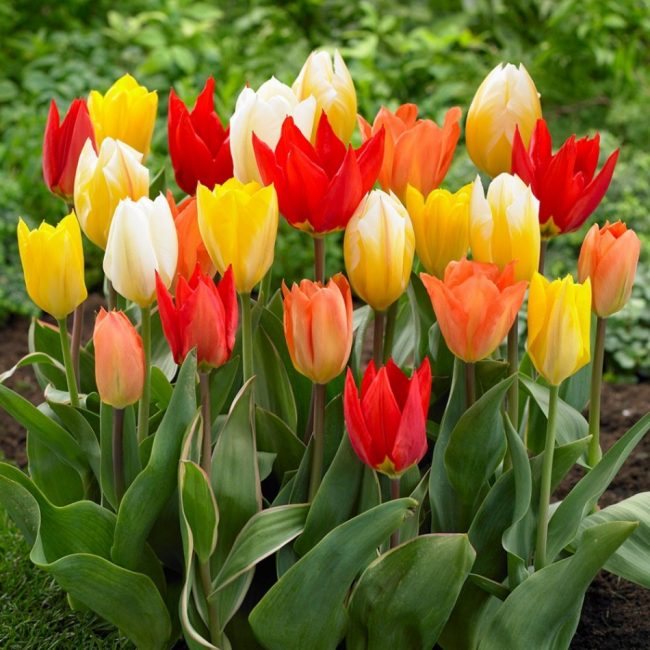
Foster's tulip
Foster's tulip. It is a hybrid of Darwin's tulip. Growth 12-15 cm. Plants are resistant to diseases and pests.
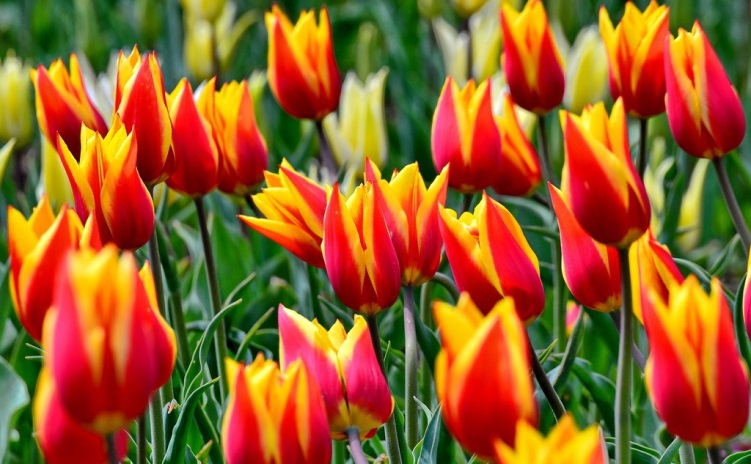
Parade
It has large goblet-shaped buds. Color: red with orange arrows.Possesses high endurance and unpretentiousness.
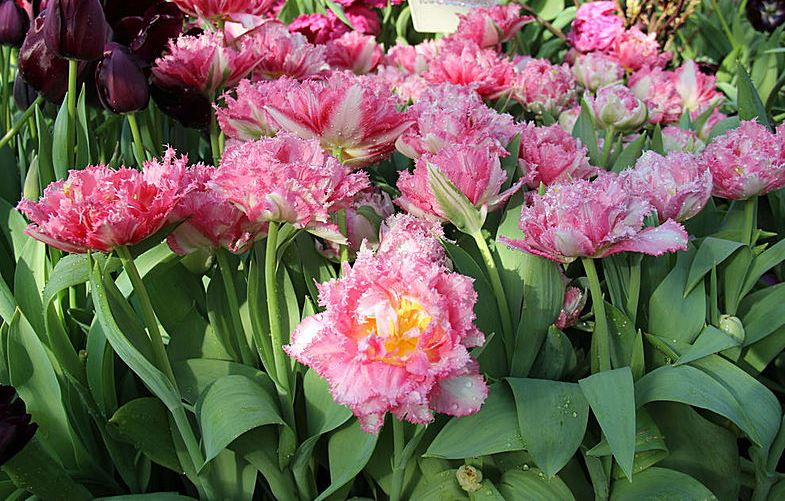
Crystal
Terry tulips. Shades from red to purple. It has a short cold storage period, which makes it possible to grow it for the New Year.
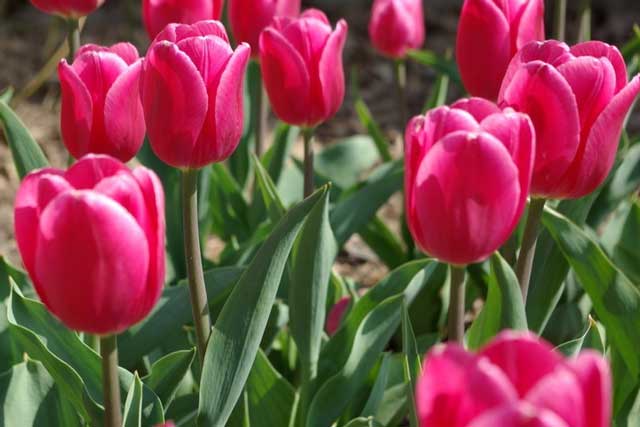
Christmas Marvel
Also "early maturing" tulip, suitable for distillation for the New Year or Christmas holidays. It is red or crimson with a white border.
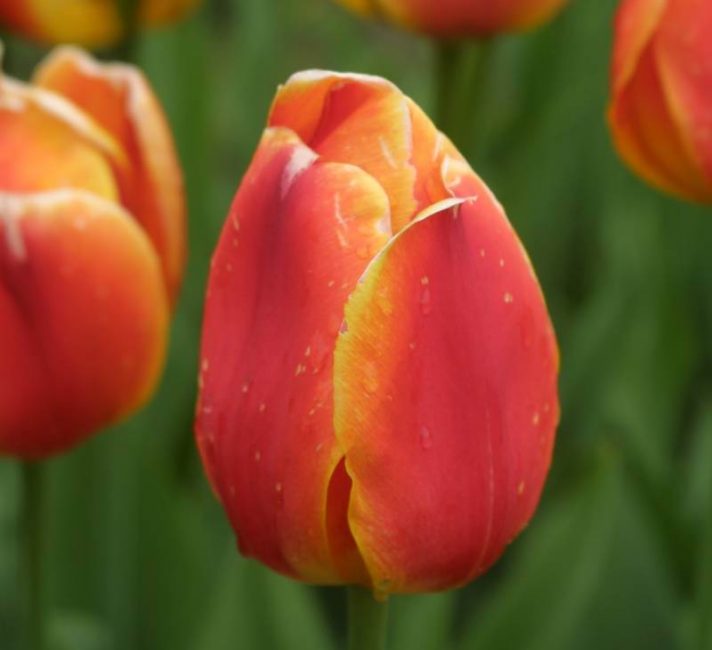
Scaborough dutch
Large bright orange flowers, suitable for medium forcing. Suitable for cultivation by 14 February and 8 March.

Apeldoorn
Plant with orange flowers. Ideal for growing by March 8th.
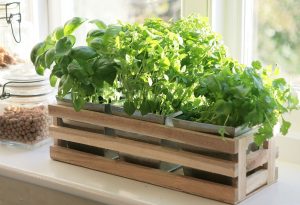
Growing greens at home - all year round with vitamins: onions, parsley, basil, garlic, the intricacies of this process (Photo & Video)
4 Under what conditions are bulbs stored?
The temperature regime for holding tulips after they bloom is very important. It is divided into 2 stages:
- 1. After harvesting the bulbs, they are stored at a temperature of 18-20 degrees for a month in a dry state. In such conditions, the formation of leaf rudiments and parts of a flower - petals, stamens, pistil - is completed. In order to get very early flowering, tulips are kept for 4-7 days at a temperature of 34 degrees.
- 2. During the cooling period of the bulbs at a temperature of 5-10 degrees, physiologically active substances are formed that affect the growth of the stem. If the temperature is not low enough, the plants grow short stems and the death of the buds is possible. The cooling time depends on the tulip variety, but not less than 12 weeks (average 14-16). The quality of flowering depends on the duration of this period.
In order for the bulb to bloom at a later date, the warm storage period is extended. Heat treatment also leads to an extension of the vegetation period after germination and faster growth of roots and stems. Too long storage at a low temperature is undesirable, as this causes the stems to be pulled out.
Before planting, the bulbs are treated in fungicide solutions at room temperature:
- Fitosporin anti-rot (1 tsp per 1 liter of water, within 1-2 hours);
- a solution of potassium permanganate of a pale pink color (for 30 minutes);
- Maxim (2 ml per 1 liter of water, 30 min.);
- Vitaros (2 ml per 1 liter of water, 2 hours);
- Fundazol (10 g per 2 liters of water, 2-3 hours).
The etching work is carried out in rubber (latex) gloves. Especially carefully you need to process the bottom of the bulbs, since it is most susceptible to diseases.


